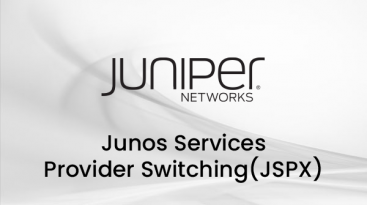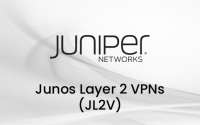Overview
This course is designed to provide students with intermediate switching knowledge and configuration examples. The course includes an overview of switching concepts such as LANs, Layer 2 address learning, bridging, virtual LANs (VLANs),provider bridging, VLAN translation, spanning-tree protocols, and Ethernet Operation, Administration, and Maintenance (OAM). This course also covers Junos operating system-specific implementations of integrated routing and bridging (IRB) interfaces,
nrouting instances, virtual switches, load balancing, and port mirroring. Furthermore, this course covers the basics of Multiple VLAN Registration Protocol (MVRP), link aggregation groups (LAGs), and multichassis LAG (MC-LAG).
Duration 2 days.
You can find current trainings on training calendar page.
Training Prerequisites
Students should have basic networking knowledge and an understanding of the Open Systems Interconnection (OSI) reference model and the TCP/IP protocol suite. Students should also attend the Introduction to the Junos Operating System (IJOS) course prior to attending this class.
Training Contents
Course Introduction
- Ethernet Switching and Virtual LANs
- Ethernet LANs
- Bridging
- Configuring and Monitoring VLANs
- Automating VLAN Administration
- Configuring and Monitoring IRB
- Layer 2 Address Learning and Forwarding
- Layer 2 Firewall Filtering
Virtual Switches
- Routing Instances Overview
- Configuring and Monitoring Virtual Switches
- Interconnecting Routing Instances
- Logical Systems
Provider Bridging
- Expanding the Bridged Network
- Provider Bridging
- Configuring and Monitoring Provider Bridging
Spanning-Tree Protocols
- Overview of STP
- Overview of RSTP
- Overview of MSTP
- Overview of VSTP
- Configuring and Monitoring Spanning-Tree Protocols
- Understanding BPDU, Loop, and Root Protection
Ethernet OAM
- OAM Overview
- LFM
- CFM
- Configuring and Monitoring Ethernet OAM
High Availability and Network Optimization
- ERP Overview
- Configuring and Monitoring ERP
- Link Aggregation Group Overview
- Configuring and Monitoring a LAG
- MC-LAG Overview
- Configuring and Monitoring an MC-LAG
Troubleshooting and Monitoring
- Introduction to Troubleshooting and Monitoring
- Troubleshooting and Monitoring Tools
- Troubleshooting Case Study: Network Congestion
Training Objectives
- Describe carrier Ethernet.
- Describe the different Ethernet standards organizations.
- Describe the Layer 2 services that are available on the MX Series 3D Ethernet Universal Edge Routers.
- Describe the function of an Ethernet LAN.
- Describe learning and forwarding in a bridging environment.
- Describe Ethernet frame filtering.
- Implement VLAN tagging.
- Describe and implement MVRP.
- Implement IRB.
- Implement a Layer 2 firewall filter.
- Describe the usage of a routing instance.
- Describe the function of a virtual router.
- Describe the function of a virtual switch.
- Describe the usage of logical systems.
- Implement a virtual switch.
- Describe interconnecting routing instances.
- Describe the different Institute of Electrical and Electronics Engineers (IEEE) VLAN stacking models.
- Describe the components of provider bridging.
- Configure and monitor provider bridging.
- Explain the purpose of the Spanning Tree Protocol (STP).
- Describe the basic operation of the STP, the Rapid Spanning Tree Protocol (RSTP), the Multiple Spanning Tree Protocol (MSTP), and the VLAN Spanning Tree Protocol (VSTP).
- Configure and monitor the STP, the RSTP, the MSTP, and the VSTP.
- Explain the purpose of bridge protocol data unit (BPDU), loop, and root protection.
- Explain typical OAM features.
- Describe the basic operation of link fault management (LFM).
- Describe the basic operation of connectivity fault management (CFM).
- Configure and monitor Ethernet OAM.
- Describe the basic operation of Ethernet Ring Protection (ERP).
- Configure and monitor ERP.
- Describe the basic operation of LAGs and MC-LAGs.
- Configure and monitor a LAG and MC-LAGs.
- Describe the basic functionality of MX Series Virtual Chassis.
- Describe a basic troubleshooting method.
- List common issues that disrupt network operations.
- Identify tools used in network troubleshooting.
- Use available tools to resolve network issues.
Who should attend?
This course benefits individuals responsible for configuring and monitoring devices running the Junos OS.
- Overview
- Prerequisites
- Contents
- Objectives
- Audience
Overview
This course is designed to provide students with intermediate switching knowledge and configuration examples. The course includes an overview of switching concepts such as LANs, Layer 2 address learning, bridging, virtual LANs (VLANs),provider bridging, VLAN translation, spanning-tree protocols, and Ethernet Operation, Administration, and Maintenance (OAM). This course also covers Junos operating system-specific implementations of integrated routing and bridging (IRB) interfaces,
nrouting instances, virtual switches, load balancing, and port mirroring. Furthermore, this course covers the basics of Multiple VLAN Registration Protocol (MVRP), link aggregation groups (LAGs), and multichassis LAG (MC-LAG).
Duration 2 days.
You can find current trainings on training calendar page.
Training Prerequisites
Students should have basic networking knowledge and an understanding of the Open Systems Interconnection (OSI) reference model and the TCP/IP protocol suite. Students should also attend the Introduction to the Junos Operating System (IJOS) course prior to attending this class.
Training Contents
Course Introduction
- Ethernet Switching and Virtual LANs
- Ethernet LANs
- Bridging
- Configuring and Monitoring VLANs
- Automating VLAN Administration
- Configuring and Monitoring IRB
- Layer 2 Address Learning and Forwarding
- Layer 2 Firewall Filtering
Virtual Switches
- Routing Instances Overview
- Configuring and Monitoring Virtual Switches
- Interconnecting Routing Instances
- Logical Systems
Provider Bridging
- Expanding the Bridged Network
- Provider Bridging
- Configuring and Monitoring Provider Bridging
Spanning-Tree Protocols
- Overview of STP
- Overview of RSTP
- Overview of MSTP
- Overview of VSTP
- Configuring and Monitoring Spanning-Tree Protocols
- Understanding BPDU, Loop, and Root Protection
Ethernet OAM
- OAM Overview
- LFM
- CFM
- Configuring and Monitoring Ethernet OAM
High Availability and Network Optimization
- ERP Overview
- Configuring and Monitoring ERP
- Link Aggregation Group Overview
- Configuring and Monitoring a LAG
- MC-LAG Overview
- Configuring and Monitoring an MC-LAG
Troubleshooting and Monitoring
- Introduction to Troubleshooting and Monitoring
- Troubleshooting and Monitoring Tools
- Troubleshooting Case Study: Network Congestion
Training Objectives
- Describe carrier Ethernet.
- Describe the different Ethernet standards organizations.
- Describe the Layer 2 services that are available on the MX Series 3D Ethernet Universal Edge Routers.
- Describe the function of an Ethernet LAN.
- Describe learning and forwarding in a bridging environment.
- Describe Ethernet frame filtering.
- Implement VLAN tagging.
- Describe and implement MVRP.
- Implement IRB.
- Implement a Layer 2 firewall filter.
- Describe the usage of a routing instance.
- Describe the function of a virtual router.
- Describe the function of a virtual switch.
- Describe the usage of logical systems.
- Implement a virtual switch.
- Describe interconnecting routing instances.
- Describe the different Institute of Electrical and Electronics Engineers (IEEE) VLAN stacking models.
- Describe the components of provider bridging.
- Configure and monitor provider bridging.
- Explain the purpose of the Spanning Tree Protocol (STP).
- Describe the basic operation of the STP, the Rapid Spanning Tree Protocol (RSTP), the Multiple Spanning Tree Protocol (MSTP), and the VLAN Spanning Tree Protocol (VSTP).
- Configure and monitor the STP, the RSTP, the MSTP, and the VSTP.
- Explain the purpose of bridge protocol data unit (BPDU), loop, and root protection.
- Explain typical OAM features.
- Describe the basic operation of link fault management (LFM).
- Describe the basic operation of connectivity fault management (CFM).
- Configure and monitor Ethernet OAM.
- Describe the basic operation of Ethernet Ring Protection (ERP).
- Configure and monitor ERP.
- Describe the basic operation of LAGs and MC-LAGs.
- Configure and monitor a LAG and MC-LAGs.
- Describe the basic functionality of MX Series Virtual Chassis.
- Describe a basic troubleshooting method.
- List common issues that disrupt network operations.
- Identify tools used in network troubleshooting.
- Use available tools to resolve network issues.
Who should attend?
This course benefits individuals responsible for configuring and monitoring devices running the Junos OS.






